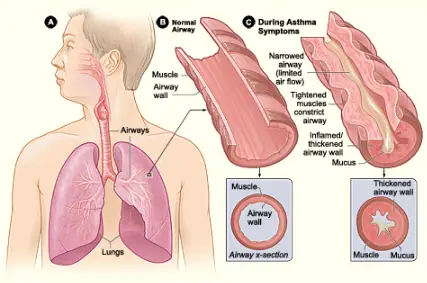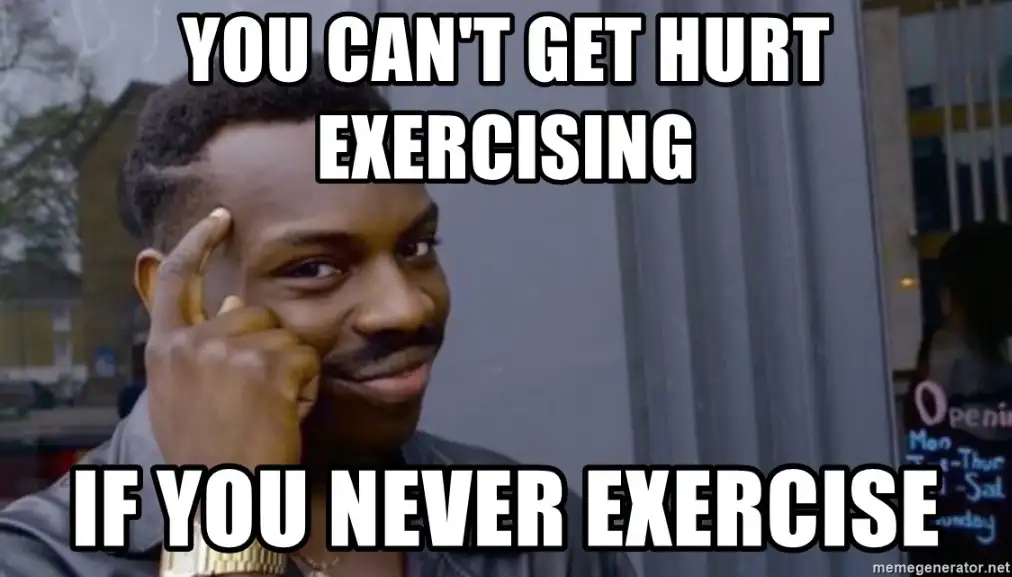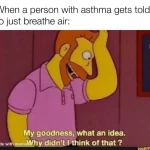Training and Assessment Delivered on Behalf of Allens Training Pty Ltd RTO 90909
Asthma: Here’s Some Breathtaking First Aid Tips

It ain’t easy being wheezy! Around one in ten of us Aussie’s have Asthma according to a 2018 report. For many, Asthma is mild, but for some it can be severe, even life threatening!
If an Asthmatic came to you for help, what would you do? In this article we’ll learn what Asthma is, what triggers it, and most importantly, some “breathtaking” tips on what to do in case of an emergency.
What is Asthma?

Ok so here’s a great picture to get us started. When someone has asthma three things happen to their airways that make it hard to breathe! 1. The outer airway muscle contracts. 2. The airway wall starts to thicken. 3. Mucus fills the airways.
As you can see in the picture. This causes the amount of air that can get through your airways to the lungs is greatly reduced.
What actually causes this?

Things like mucus in the airways, and tightening airways are the body’s way of dealing with irritations. But for Asthmatics, their airways are hypersensitive. Their airways overreact to even the smallest of irritations.
What are Asthma triggers?

There are a whole lot of things that can cause an Asthma flare up.
Let’s start with the usual suspects. Irritants like cigarette smoke, fires, perfumes, cleaning products, allergens like spores, pollen and so forth. Some medications, food preservatives, colours and flavours can also cause problems.
Ok, so let’s go with some less usual ones. Strong emotions like laughing and crying can also be triggers. Guys, this is a great way to get out of watching “The Notebook” again. I hate to bring this meme out again after our last article on anaphylaxis…. But exercise is another trigger.
What Asthma looks like
Here’s what to look out for. A person who has Asthma might be wheezing, when airways narrow it causes that high pitched whistle. You may also hear coughing.
For some though, there may be no real wheeze or cough. Often Asthma could just present itself as difficulty breathing and a tight chest or chest pain. So what else could you look for? You may see their chest sucked in, discolouration of their lips (blueish) and pale and sweaty skin.
How quickly will symptoms come on? It can vary from a few minutes, to many days to increase in severity.
Breathtaking Asthma Tips
So what do you do to help someone if they have Asthma? There are two main types of medicine for Asthma: preventatives and relievers.
How do they work? Preventatives make the airways less sensitive and dry up mucus.. Relievers relax the airway muscles quickly providing quick relief.
If someone is having serious Asthma and needs our help, our focus will be on helping them relieve their symptoms. So as first aiders, our focus is generally relievers, not preventatives.

Body Position
Body position makes a big difference. It’s recommended that if someone has Asthma, you sit them upright. It’s easier to breathe upright than lying down.
Make sure to be reassuring. Asthma is stressful, and that stress can cause the airways to further restrict. Your calm manner can make a difference.
Action Plans
If someone comes to you suffering from Asthma, it’s good to know if they have an Asthma action plan. To quote the A-Team: You’ll “love it when a plan comes together.”
Asthma Action plans contain medication and dosage information that will tell you what to do, as well as when to call emergency services. As Asthma can be different for each person, you’ll get a better result with a tailored plan.
4X4X4

But not all Asthma sufferers have a plan, or if one’s not available, they may not remember what it says. In that case, Australia has a national method to treat them.
This method is called 4x4x4. It’s easy to remember. Just think of a Jeep! To carry out the 4x4x4 method you’ll need a reliever medication like ventolin, and a spacer if possible. Then here’s what you’ll do
Give them 4 Puffs of a reliever.
After each puff, make them take 4 Breaths.
Then wait for 4 Minutes.
After 4 minutes, if there is no improvement, go through the process again! If they haven’t improved afterwards, it’s ambulance time. Make sure to contact 000 immediately and let them know it’s an Asthma emergency. Keep going through the 4x4x4 plan until the ambulance arrives.
If a person doesn’t have a spacer, keep following the plan. Just remember they wont need to take 4 breaths for each puff if they have a spacer.

Of course, if at any time a person becomes unconscious, or completely stops breathing. Remember to follow the DRSABCD action plan. You can learn more about it in our ultimate guide. So now we’ve tackled the main what to do’s for Asthma, let’s look at some other handy tips.
Why Spacers Matter
For Asthma medication to work, you’ll need it to get into your airways. When someone uses a reliever straight into their mouth, a lot of the medication hits the back of their throat, or the mouth.
When you use a spacer, the medication goes into the spacer and can then be breathed down into your airways. This means more medication where it matters!
Anaphylaxis and Asthma
Does wheezing, shortness of breath and restricted airways remind you of another common condition? When someone has a severe allergy, their body can have an anaphylactic reaction. If someone has a history of anaphylaxis and isn’t sure which is causing breathing difficulties, treat them for anaphylaxis first, then move on to the asthma if thing’s haven’t improved.
Let’s Wrap Up
So today we’ve learnt that Asthma is caused by hypersensitive airways, we’ve learnt what triggers this reaction, and we’ve also considered what to know about treating it! Remembering what to do, will help you to breathe easy in an emergency!

